Abstract
This article discusses bone as a source of lead to the rest of the body and as a record of past lead exposure. Bone lead levels generally increase with age at rates dependent on the skeletal site and lead exposure. After occupational exposure, the slow decline in blood lead, a 5- to 19-year half-life, reflects the long skeletal half-life. Repeated measurements of bone lead demonstrate the slow elimination of lead from bone. Stable isotope ratios have revealed many details of skeletal uptake and subsequent release. The bulk turnover rates for compact bone are about 2% per year and 8% for spine. Turnover activity varies with age and health. Even though lead approximates calcium, radium, strontium, barium, fluorine, and other bone seekers, the rates for each are different. A simple, two-pool (bone and blood) kinetic model is presented with proposed numerical values for the changes in blood lead levels that occur with changes in turnover rates. Two approaches are offered to further quantify lead turnover. One involves a study of subjects with known past exposure. Changes in the ratio of blood lead to bone lead with time would reflect the course of bone lead availability. Also, stable isotopes and subjects who move from one geographical area to another offer opportunities. Sequential isotope measurements would indicate how much of the lead in blood is from current exposure or bone stores, distinct from changes in absorption or excretion.
Full text
PDF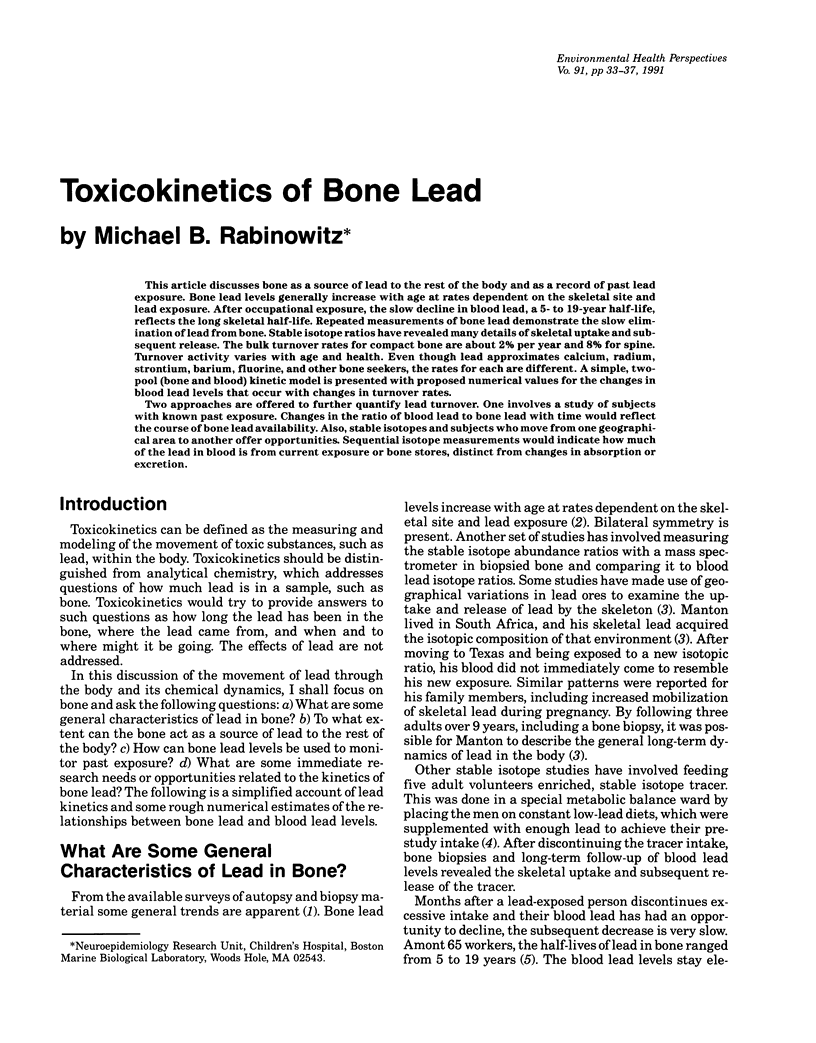
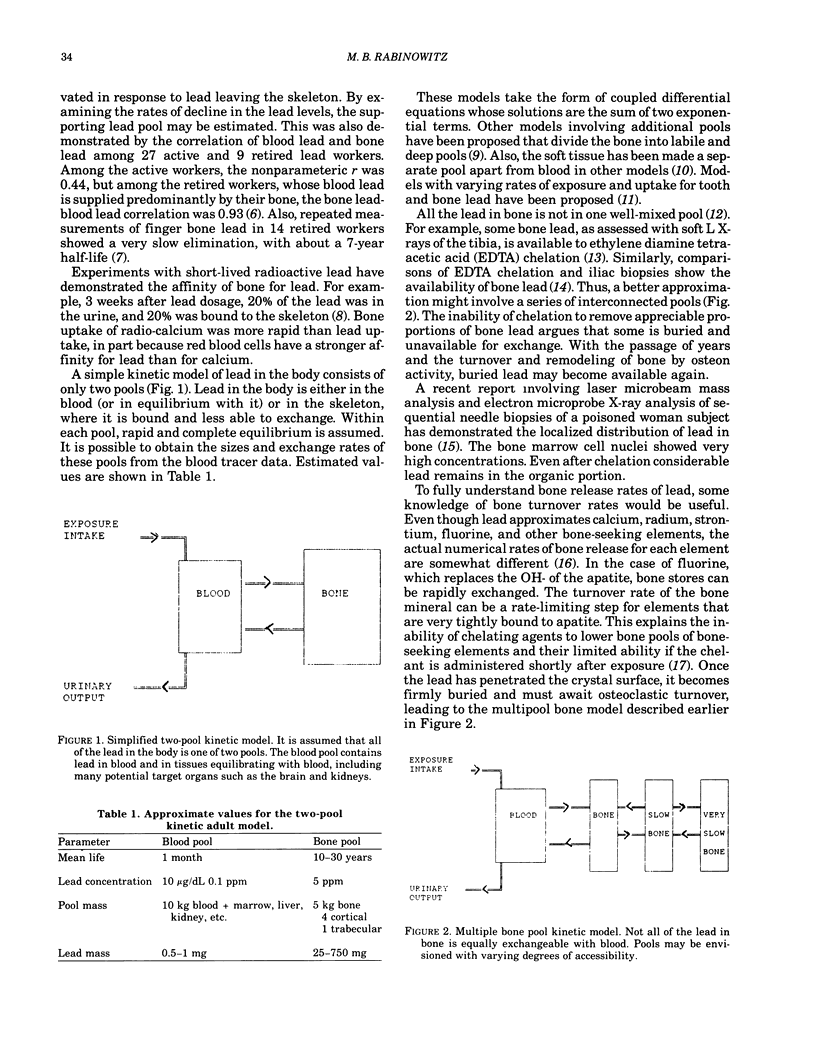
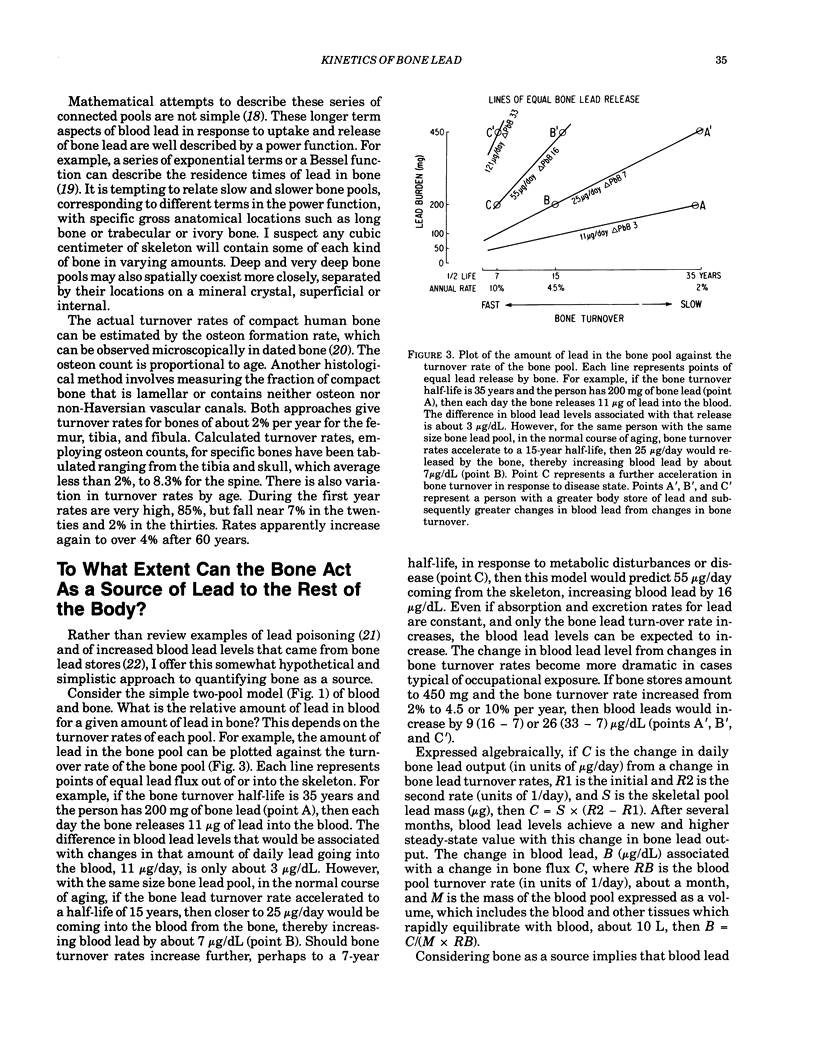
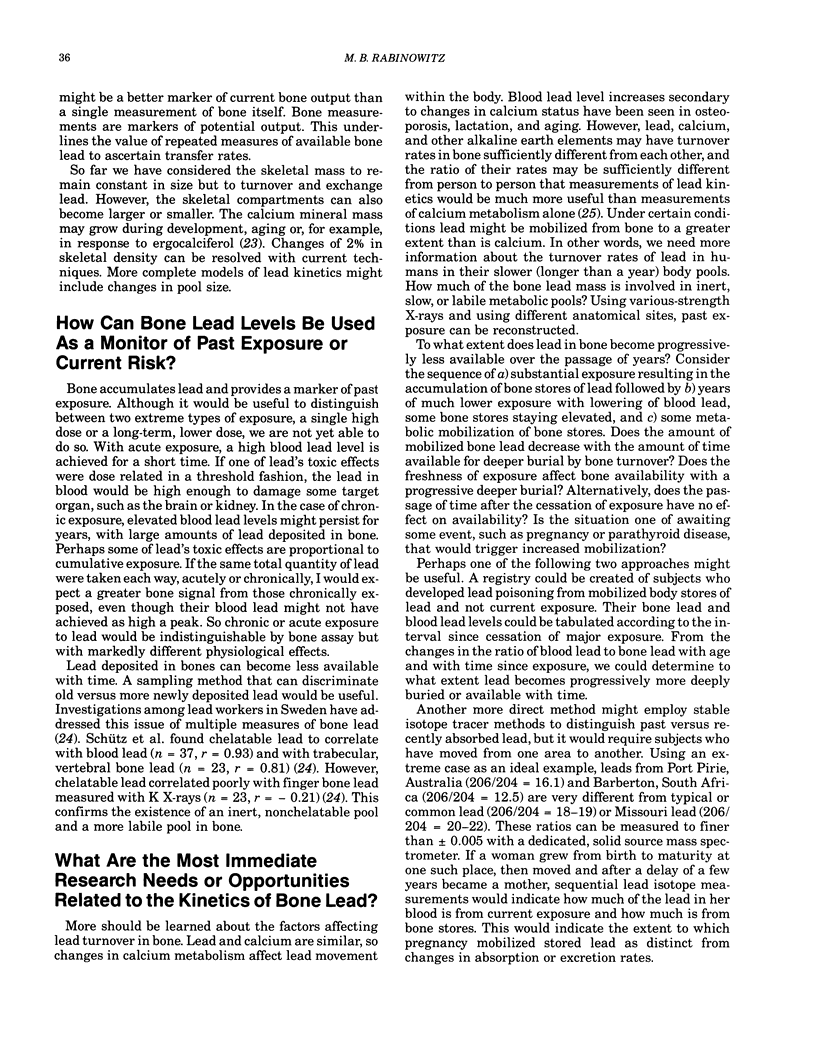
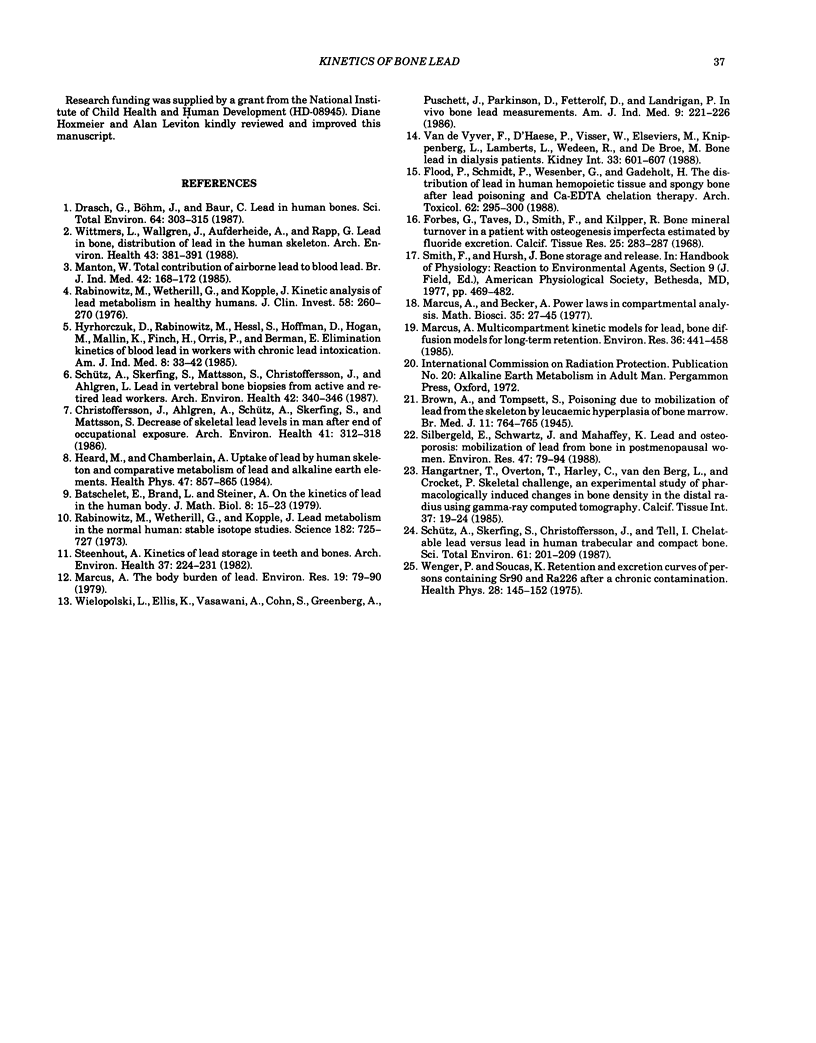
Selected References
These references are in PubMed. This may not be the complete list of references from this article.
- Batschelet E., Brand L., Steiner A. On the kinetics of lead in the human body. J Math Biol. 1979 Jul 13;8(1):15–23. doi: 10.1007/BF00280582. [DOI] [PubMed] [Google Scholar]
- Christoffersson J. O., Ahlgren L., Schütz A., Skerfving S., Mattsson S. Decrease of skeletal lead levels in man after end of occupational exposure. Arch Environ Health. 1986 Sep-Oct;41(5):312–318. doi: 10.1080/00039896.1986.9936703. [DOI] [PubMed] [Google Scholar]
- Drasch G. A., Böhm J., Baur C. Lead in human bones. Investigations on an occupationally non-exposed population in southern Bavaria (F.R.G.). I. Adults. Sci Total Environ. 1987 Jul;64(3):303–315. doi: 10.1016/0048-9697(87)90252-x. [DOI] [PubMed] [Google Scholar]
- Flood P. R., Schmidt P. F., Wesenberg G. R., Gadeholt H. The distribution of lead in human hemopoietic tissue and spongy bone after lead poisoning and Ca-EDTA chelation therapy. Observations made by atomic absorption spectroscopy, laser microbeam mass analysis and electron microbeam X-ray analysis. Arch Toxicol. 1988;62(4):295–300. doi: 10.1007/BF00332490. [DOI] [PubMed] [Google Scholar]
- Forbes G. B., Taves D. R., Smith F. A., Kilpper R. W. Bone mineral turnover in a patient with osteogenesis imperfecta estimated by fluoride excretion. Calcif Tissue Res. 1978 Aug 18;25(3):283–287. doi: 10.1007/BF02010782. [DOI] [PubMed] [Google Scholar]
- Hangartner T. N., Overton T. R., Harley C. H., van den Berg L., Crockford P. M. Skeletal challenge: an experimental study of pharmacologically induced changes in bone density in the distal radius, using gamma-ray computed tomography. Calcif Tissue Int. 1985 Jan;37(1):19–24. doi: 10.1007/BF02557673. [DOI] [PubMed] [Google Scholar]
- Heard M. J., Chamberlain A. C. Uptake of Pb by human skeleton and comparative metabolism of Pb and alkaline earth elements. Health Phys. 1984 Dec;47(6):857–865. doi: 10.1097/00004032-198412000-00006. [DOI] [PubMed] [Google Scholar]
- Hryhorczuk D. O., Rabinowitz M. B., Hessl S. M., Hoffman D., Hogan M. M., Mallin K., Finch H., Orris P., Berman E. Elimination kinetics of blood lead in workers with chronic lead intoxication. Am J Ind Med. 1985;8(1):33–42. doi: 10.1002/ajim.4700080105. [DOI] [PubMed] [Google Scholar]
- Manton W. I. Total contribution of airborne lead to blood lead. Br J Ind Med. 1985 Mar;42(3):168–172. doi: 10.1136/oem.42.3.168. [DOI] [PMC free article] [PubMed] [Google Scholar]
- Marcus A. H. Multicompartment kinetic models for lead. I. Bone diffusion models for long-term retention. Environ Res. 1985 Apr;36(2):441–458. doi: 10.1016/0013-9351(85)90037-4. [DOI] [PubMed] [Google Scholar]
- Marcus A. H. The body burden of lead: comparison of mathematical models for accumulation. Environ Res. 1979 Jun;19(1):79–90. doi: 10.1016/0013-9351(79)90036-7. [DOI] [PubMed] [Google Scholar]
- Rabinowitz M. B., Wetherill G. W., Kopple J. D. Kinetic analysis of lead metabolism in healthy humans. J Clin Invest. 1976 Aug;58(2):260–270. doi: 10.1172/JCI108467. [DOI] [PMC free article] [PubMed] [Google Scholar]
- Rabinowitz M. B., Wetherill G. W., Kopple J. D. Lead metabolism in the normal human: stable isotope studies. Science. 1973 Nov 16;182(4113):725–727. doi: 10.1126/science.182.4113.725. [DOI] [PubMed] [Google Scholar]
- Schütz A., Skerfving S., Christoffersson J. O., Ahlgren L., Mattson S. Lead in vertebral bone biopsies from active and retired lead workers. Arch Environ Health. 1987 Nov-Dec;42(6):340–346. doi: 10.1080/00039896.1987.9934356. [DOI] [PubMed] [Google Scholar]
- Schütz A., Skerfving S., Christoffersson J. O., Tell I. Chelatable lead versus lead in human trabecular and compact bone. Sci Total Environ. 1987 Mar;61:201–209. doi: 10.1016/0048-9697(87)90367-6. [DOI] [PubMed] [Google Scholar]
- Silbergeld E. K., Schwartz J., Mahaffey K. Lead and osteoporosis: mobilization of lead from bone in postmenopausal women. Environ Res. 1988 Oct;47(1):79–94. doi: 10.1016/s0013-9351(88)80023-9. [DOI] [PubMed] [Google Scholar]
- Steenhout A. Kinetics of lead storage in teeth and bones: an epidemiologic approach. Arch Environ Health. 1982 Jul-Aug;37(4):224–231. doi: 10.1080/00039896.1982.10667569. [DOI] [PubMed] [Google Scholar]
- Van de Vyver F. L., D'Haese P. C., Visser W. J., Elseviers M. M., Knippenberg L. J., Lamberts L. V., Wedeen R. P., De Broe M. E. Bone lead in dialysis patients. Kidney Int. 1988 Feb;33(2):601–607. doi: 10.1038/ki.1988.39. [DOI] [PubMed] [Google Scholar]
- Wenger P., Soucas K. Retention and excretion curves of persons containing 90Sr and 226Ra after a chronic contamination. Health Phys. 1975 Feb;28(2):145–152. doi: 10.1097/00004032-197502000-00007. [DOI] [PubMed] [Google Scholar]
- Wielopolski L., Ellis K. J., Vaswani A. N., Cohn S. H., Greenberg A., Puschett J. B., Parkinson D. K., Fetterolf D. E., Landrigan P. J. In vivo bone lead measurements: a rapid monitoring method for cumulative lead exposure. Am J Ind Med. 1986;9(3):221–226. doi: 10.1002/ajim.4700090304. [DOI] [PubMed] [Google Scholar]
- Wittmers L. E., Jr, Aufderheide A. C., Wallgren J., Rapp G., Jr, Alich A. Lead in bone. IV. Distribution of lead in the human skeleton. Arch Environ Health. 1988 Nov-Dec;43(6):381–391. doi: 10.1080/00039896.1988.9935855. [DOI] [PubMed] [Google Scholar]


